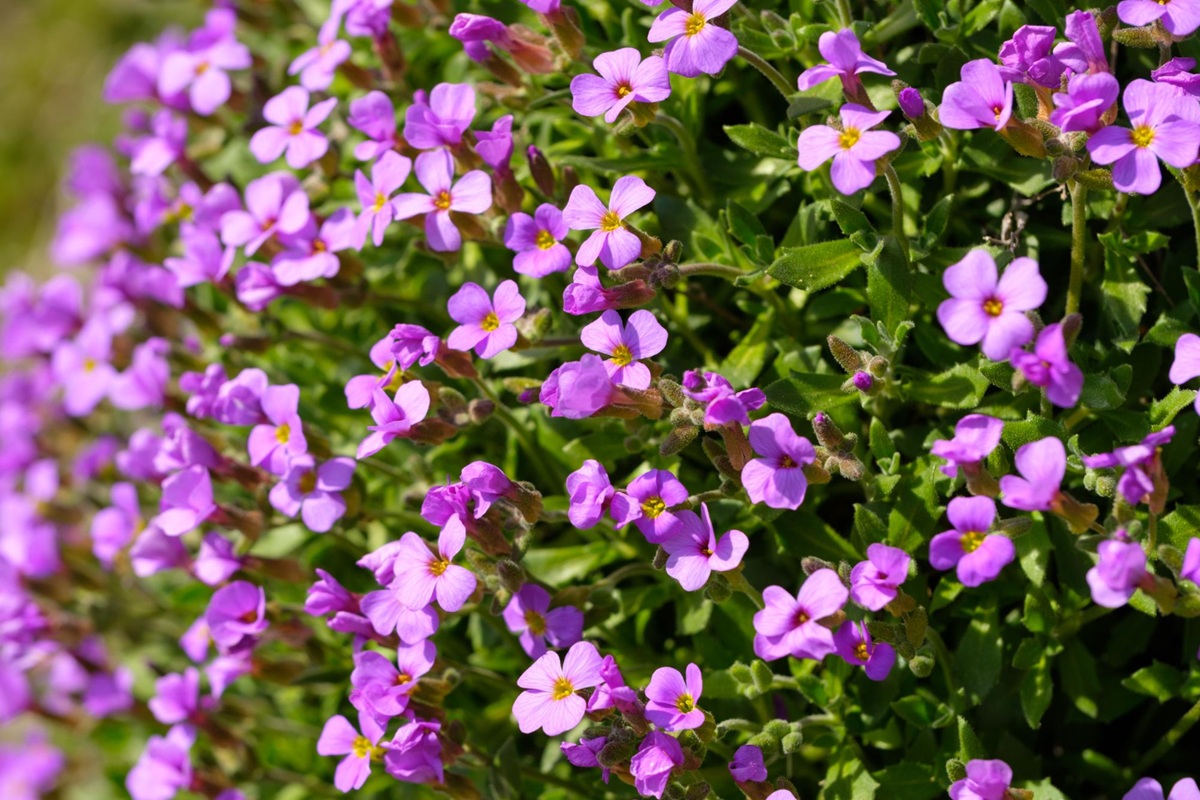If you want to beautify the borders of your vegetable garden while attracting pollinating insects, why not choose an easy-to-grow plant?
Aubrieta, a small perennial that seems rather modest at the time of purchase, becomes a true delight for the eyes by the spring following its planting. It quickly forms lovely flowering cushions that remain decorative for several years.
Highlighting aubrieta: A decorative and practical perennial
Originally from the mountainous regions of southern Europe and Asia Minor, aubrieta (Aubrieta deltoidea) belongs to the same botanical family as cabbages and canola: the brassicaceae. Its name honors Claude Aubriet, a renowned French painter and botanist from the 18th century.
This charming little perennial grows slowly in large, compact clumps, reaching up to sixty centimeters in diameter with a modest height of 10 to 15 cm. It loves the sun but can tolerate partial shade and withstands temperatures as low as -15 °C without any problems.
Its colorful flowers, which appear from early spring (March to June depending on your region), completely cover the plant in vibrant hues like blue, violet, mauve, pink, or even white. This abundant blooming makes its gray-green foliage almost invisible for several weeks.
Why choose to sow aubrieta in May?
May is the ideal time to sow aubrieta in the garden. Why this choice? Simply because the temperatures during this month are perfect: the risk of frost is gone and the soil receives gentle warmth that is conducive to good seed germination.
The result is promising: well-established plants that will root comfortably before winter arrives. By the following spring, you will already enjoy a generous blooming.
An additional advantage: aubrieta naturally reseeds itself, ensuring its longevity through the seasons.
Benefits of sowing compared to buying a plant
While garden centers offer ready-to-plant aubrieta pots, sowing has its own advantages:
- Very attractive cost: buying seeds is significantly more economical than purchasing pots.
- Varied choices in colors and varieties: you have access to a broader palette.
- Personal satisfaction: watching your plants grow from seed is truly gratifying.
- Practical flexibility: you can sow the seeds directly in the ground or in pots, depending on your preferences.
Methods and tips for successfully sowing aubrieta in May
Are you considering sowing directly in the ground? Here are the steps to follow:
- Loosen the soil previously cleaned of weeds and small stones.
- Dig shallow furrows (about 0.5 cm deep).
- Sow the seeds lightly as they are very fine.
- Cover with fine soil or sifted potting mix.
- Lightly press down, then water gently.
- Ensure that the soil remains moist until germination (about two weeks).
Sowing in pots offers greater control over germination and growth:
- Fill your pots with fine seed-specific potting soil.
- Sow on the surface, cover very lightly, then gently moisten the medium.
- Keep in partial shade, always slightly moist.
- Once true leaves appear, keep only the strongest plants.
- Transplant them permanently when they have 4 or 5 leaves.
Flowering borders in the vegetable garden: multiple benefits
Planting your aubrieta near the vegetable garden has several valuable advantages:
A pleasant natural setting
With its sprawling profile, aubrieta gracefully defines the boundaries of a garden bed, pathways, or even square vegetable plots. When placed at the base of fruit trees, it adds a soft floral touch that breaks the monotony of straight lines.
A boost for pollinators
The early and abundant flowers attract bees, bumblebees, and butterflies as soon as the first warmth of spring arrives. This offers crucial support for boosting the pollination of nearby plants: tomatoes, squash, or strawberries thrive on this.
A protective cover for the soil
By densely covering the ground, aubrieta significantly limits the emergence of weeds, preserves soil moisture, and prevents superficial erosion.
Which varieties of aubrieta to choose for the garden?
Among the essential varieties for vibrant effects, consider:
- Aubrieta deltoidea ‘Cascade Purple’ for its intense violet, perfect for hanging.
- Aubrieta ‘Royal Blue’, known for its particularly bright blue.
- Aubrieta ‘Red Cascade’, very decorative and vivid in magenta red.
- Aubrieta ‘Cascade Mix’, offering a varied mix in pink, white, and shades of violet.
Tips for minimal effective maintenance
A few simple rules for caring for aubrieta:
- Water moderately after planting. Afterwards, reduce watering unless there is prolonged dryness.
- Provide a bit of mature compost on the surface each spring to nourish your plant without overdoing it.
- Trim after flowering (early June) to maintain a compact appearance.
- Divide the clumps approximately every three years to renew the vigor of the plants.!
Possible issues? Watch out for slugs and excessive moisture, which can lead to rot. Maintain good soil drainage and protect with natural traps (ashes, beer).
Have you tried aubrieta in your garden? What experiences have you had with this very flowering hardy plant? Feel free to share your results or ask questions in the comments! We would love to hear your thoughts!
I’m a disabled, xennial Christ-follower, slightly off kilter (but aren’t all “ar-teeests”?).
Hope you enjoy my rantings, don’t take my sarcasm too seriously and know that comments are welcome. 🙂


Leave a Reply